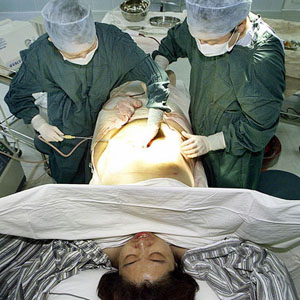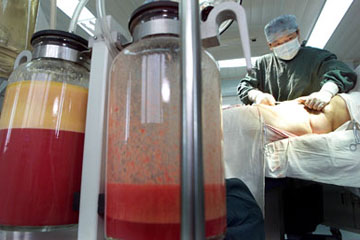
Liu Jin/AFP/Getty Images
Two Chinese doctors perform liposuction on a woman in Shanghai. Plastic surgery is growing in popularity in China, but if it's too invasive for you, smart liposuction is one alternative.
Imagine if there were a magic pill that would instantly melt away fat, leaving you with the perfect Hollywood body. Unfortunately, no such thing exists just yet, but science is making great strides toward finding ways to slim us down. In lieu of diet and exercise, a comparatively quick -- but not so painless --way to shed the weight is through and moves back and forth through the fat cells, breaking them up. When this process is complete, the surgeon uses a vacuum tube to suction out the fat into a flask. The procedure works well, but because it is relatively invasive, it can have some unpleasant side effects. For a more in-depth explanation of the procedure, read our article on How Liposuction Works.
If surgery isn't for you, there are a few new liposuction treatments on the market to choose from. The latest technology involves ultrasound-based techniques for recontouring the body. These cosmetic procedures can be performed in a doctor's office with a small dose of anesthetic -- no surgery required.
In Vaser LipoSelection, the patient is placed under general, local or intravenous sedation. The doctor creates a tiny incision in the area to be treated and fills it with a solution containing epinephrine, which shrinks blood vessels to reduce bleeding, and an anesthetic, which numbs the area. The doctor then inserts an ultrasonic probe that releases sound waves. The sound waves break up fatty tissue in areas such as the abdomen, arms, back, knees and hips -- or "love handles" -- while leaving nearby tissue intact. The doctor finishes the procedure by using suction to remove the emulsified fat.
UltraShape and LipoSonix are procedures that use an ultrasound to break up fat cells from outside the body. With UltraShape and LipoSonix, there is no need for an incision. While the patient lies on a bed, the technician uses a handheld device to deliver ultrasound energy to the area that's being treated. The energy disrupts the fat cell membranes and ruptures the cells. The body then transports the fat to the liver, where it is removed.
Related Articles |
An even more revolutionary version of liposuction called SmartLipo removes fat with a laser. Because it's less invasive, SmartLipo has fewer side effects than traditional liposuction. Laser-assisted liposuction has been around in Europe for about five years. In 2006, the U.S. Food and Drug Administration approved the first laser-assisted liposuction procedure, SmartLipo by Cynosure, Inc., in the United States.
In this article, will see how laser-assisted liposuction works, find out how safe it is and learn whether it really can melt away fat to give you the body you've always wanted.
Advertisement
